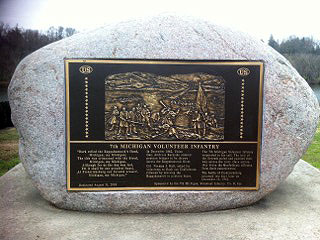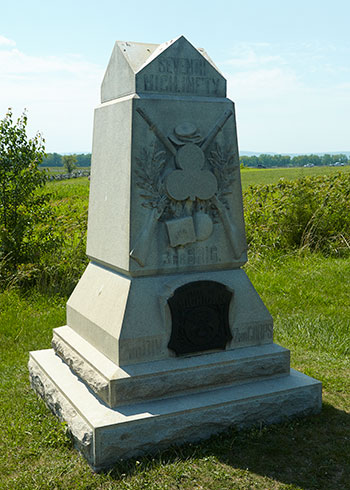History of the 7th Michigan Infantry
The 7th Michigan was mustered into Federal service on August 22, 1861 in Monroe, Michigan. The companies assigned to the Seventh were made up of militia units. The militia units formed the base of many of the companies. They had or took on unique names with many identifying where they came from in the name. For the Seventh these included the “Union Guard” of Port Huron, from Mason the “Curtenius Guard”, the “Jonesville Light Guard”, “Monroe Light Guard”, “Tuscola Volunteers”, from Farmington the “Blair Guards”, the “Lapeer Guards”, one company from Pontiac, the “Prairieville Rangers” and the “Burr Oak Rangers”. The Regiment received state issued uniforms that were produced under the same contract as the uniforms for the 5th and 6th Michigan Infantry. These contracts were for jackets and trousers from Samuel Sykes of Detroit made from heavy dark blue wool cloth along with dark blue caps from F. Buhl. Other various Michigan companies procured contracts to supply these three regiments with other items such as overcoats, shoes, canteens, cups eating utensils and haversacks. With their new uniforms and accouterments the Regiment left Michigan on September 5th with 884 officers and men.
Later that same month the Regiment arrived in Washington and was brigaded with several Massachusetts regiments known as Lander’s Brigade. The next several weeks were passed at Camp Benton as the Michigan men adjusted to army life. On October 20, 1861 balloon reconnaissance reported that some of the Confederates were leaving the area. It was thought that a demonstration might cause the enemy to leave that location completely. The battle that ensued which was a Federal defeat was called Ball’s Bluff. The 7th Michigan did not take part in the fighting but was near by digging entrenchments. General Stone stated in his report the reason the new regiment didn’t take part. He states, “I did not wish to use the 7th Michigan Regiment as they were poorly armed. They were excellent men, but I deemed it unfair to put them into battle with the poor arms they had. The 7th was given entrenching tools and told to dig.” The Seventh’s poor arms that are referenced were converted Belgian flintlocks that were very unreliable and inaccurate. After the failed movement at Ball’s Bluff the Brigade went back to Camp Benton for winter quarters.
The poor arms of the new Regiment were an obvious problem even before Ball Bluff. The unreliable muskets are written about on August 22, 1861 by General Alpheus S. Williams. He wrote “Our fine Seventh Regiment, Col. Grosvenor commanding, which was across the river at Edwards Ferry, is armed with the Belgian Rifle, not one in ten of which can be discharged.” Thankfully for the Regiment before the close of the year their poor weapon problem would start to be solved. Several officers including Colonel Grosvenor, Captain Darrah and Captain Hunt went back to Michigan near the end of 1861 to get new arms and tents for the men. With help from Senator Zachariah Chandler they succeeded in their task of getting Springfield Rifled Muskets.
Once the spring of 1862 was underway the Seventh left on the Peninsular Campaign in Virginia. From May until August they were engaged in numerous battles including Yorktown, Fair Oaks, Savage Station, White Oak Swamp, Glendale and Malvern Hill. Suffering casualties throughout the regiment received many accolades from superiors for its performance. These causalities would be small in comparison to what they experienced on September 17, 1862. That day they were engaged at the battle of Antietam. The men were veterans now and could sense a large battle was coming. On September 16 Private Frederick Oesterle wrote “We received 40 rounds of cartridges in our boxes and 20 additional rounds in our haversack. Many goodbyes were said and letters were sent home to our loved ones.” During the severe fighting in the West Woods the next day the Seventh Michigan suffered 55% casualties.
 Time for rest was short lived for the men and their next big challenge was less then three months away. In December of 1862 men of the Seventh were chosen to cross the Rappahannock River in pontoon boats at Fredericksburg in order to drive out enemy sharpshooters. These sharpshooters were making it to hot for the engineers to construct the needed bridges for the Army of the Potomac to cross. The Seventh crossed in the boats under heavy fire with no protection from it. They succeeded in their mission and captured a number of prisoners in the process. This gallant action earned them a reputation of bravery that was never forgotten.
Time for rest was short lived for the men and their next big challenge was less then three months away. In December of 1862 men of the Seventh were chosen to cross the Rappahannock River in pontoon boats at Fredericksburg in order to drive out enemy sharpshooters. These sharpshooters were making it to hot for the engineers to construct the needed bridges for the Army of the Potomac to cross. The Seventh crossed in the boats under heavy fire with no protection from it. They succeeded in their mission and captured a number of prisoners in the process. This gallant action earned them a reputation of bravery that was never forgotten.
Their bravery was tested again at Gettysburg on July 2-3, 1863. They arrived on the battlefield on July 2 positioned at the center of the Union line. The following day the men of the Seventh took part in repulsing Pickett’s Charge near the copse of trees. After the battle of Gettysburg in July 1863 the Seventh Michigan participated in the pursuit of Lee’s army. After which they were sent to New York City in response to the recent draft riots. They and other veteran regiments were to remain in the city until the draft was over to ensure no more violent riots broke out again.
 Even though the men had been through much suffering the majority of them still believed in the cause they were fighting for. On January 2, 1864 162 men had reenlisted for another three years and received a 30 day furlough for the commitment. For a brief but needed time these men were home with their families again in Monroe, Michigan.
Even though the men had been through much suffering the majority of them still believed in the cause they were fighting for. On January 2, 1864 162 men had reenlisted for another three years and received a 30 day furlough for the commitment. For a brief but needed time these men were home with their families again in Monroe, Michigan.
May of that year some of the worst fighting of the war would take place and the Seventh pitched in as always. Over the next several weeks they would be engaged at the Wilderness, Spotsylvania, Cold Harbor and outside Petersburg before settling into a siege around that city with the rest of the Army. The siege around Petersburg lasted until April of 1865 when the Army of Northern Virginia pulled away and towards Appomattox Court House. The Seventh Michigan Infantry took part in the pursuit of Lee across Virginia before he surrendered on April 9, 1865.
After the surrender the Seventh started its journey north to Washington to take part in the Grand Review. The men were no doubt eager to get home but had to take the long way to get there. The men were not happy when on June 6 they were ordered to go to Louisville, Kentucky. Their journey did not seem rushed and they must have taken their time, as they didn’t arrive in Louisville until the 22nd. However, their stay was short lived and by July 7, 1865 the Regiment was finally mustered out, back in Monroe and being disbanded.
The gallant Seventh Michigan Infantry had 1,375 names on its rolls with replacements and just over 50% of those men became a casualty of war. These casualties include the men who were killed in action, died later of their wounds, succumbed to disease and died in Confederate prisons. The largest numbers of casualties, at 344, are those that suffered from a disability because of a wound or disease during their service.
ORGANIZATION
Organized at Monroe, Mich., and mustered in August 22, 1861.
Left State for Washington, D.C., September 5.
Attached to Lander's Brigade, Stone's Division, Army of the Potomac, to March, 1862.
3rd Brigade, 2nd Division, 2nd Army Corps, Army of the Potomac, to December, 1863.
1st Brigade, 2nd Division, 2nd Army Corps, Army of the Potomac to July, 1865.
Roster of Men of the 7th - Links to Photos of Men where known - Coming Soon
| Field and Staff | Company A | Company B | Company C |
| Company D | Company E | Company F | Company G |
| Company H | Company I | Company K | Unassigned Men |
Links Related to the 7th Michigan Infantry
| 7th Michigan Flag information | There is only one flag from the 7th Michigan Infantry in the State flag collection. Howver, there is also one at the Monroe Historical Museum. This link takes you to our flag page and specifically to the part about the 7th's flags. | 7th Michigan Flags |
| The 7th Michigan Infantry at Antietam | An article in a blog telling the story of the battle of Antietam specifically focusing on the role of the 7th Michigan Infantry. This blog has several great photos in it. | http://antietamjournal.blogspot.com/2014/08/the-7th-michigan-infantry-at-antietam.html?m=1 |
7th Michigan Infantry, Company B - reenactment group |
This long standing 501c3 organization preserves and promotes the memory of the men of the 7th Michigan Infantry. They are based in Lansing, Michigan. | 7th Michigan, Company B |
| 7th Michigan Gettyburg Monument | Follow this link to our page about the Michigan monuments at Gettysburg. This link will take you directly to the section on the 7th Michigan Infantry. | 7th Michigan Infantry Gettysburg Monument |
| William Shafter Monument | Located in Galesburg, MI, this monument pays tribute to William Shafter whose service at Fair Oaks while a lieutenant in the 7th Michigan earned him the Congressional Medal of Honor. | |
Books about the 7th Michigan
| Small Arms Used by Michigan Troops in the Civil War - Edited by Donald F. Kigar | This book is part of the Centennial Commission Books. It is a great reference on what regiment was carrying what weapon throughout the war. | |
Michigan at Antietam - By Brian James Egen and Jack Dempsey |
America's single bloodiest day was at the Battle of Antietam, and Michigan played a prominent role. Discover the state's connections to the Lost Order, one of the Civil War's greatest mysteries. Explore George A. Custer's role as a staff officer in combat. Mourn the extraordinary losses Michiganders suffered, including one regiment losing nearly half its strength at the epicenter of the battle. The Wolverine State's contributions to secure the Union and enable the Emancipation Proclamation are vast and worthy of a monument on the battlefield. | |
